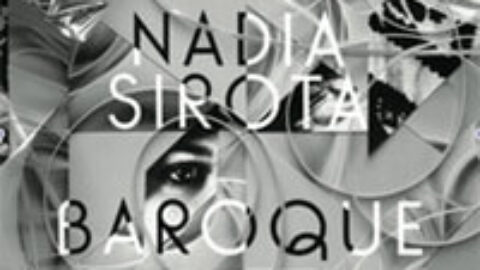 Nadia Sirota may very well become known as the most important violist of her generation.
Nadia Sirota may very well become known as the most important violist of her generation.
With elite technical prowess and a hyper-attentive ear for the composer’s intent, her musical presence can be regularly heard in new music ensembles such as ACME and yMusic, and in collaboration with numerous bands. Her passionate advocacy of contemporary classical music has extended to her award-winning WQXR radio show “Nadia Sirota on Q2.” Perhaps most significant of all is the growing body of work for solo viola that Sirota has commissioned from composers.

“Baroque,” released March 26 via New Amsterdam Records, is Sirota’s second studio album of such commissions. Featuring six wildly varied compositions, this intensely intimate set finds the violist expanding the musical and emotional palette of her debut First Things First to further develop the distinctive musical dialect that is quintessential Sirota. The title Baroque refers to compositional traits from Bach’s era that have been extrapolated and interpreted for contemporary music by living composers.
First and foremost, Nadia Sirota brings out the best in the composers who write for her. The violist’s performance style is deliberate, but the music never lags. She favors a visceral approach to her instrument, but her phrasing is direct and lyrical. Her sense of articulation makes audible every flick of the wrist and every bounce of the bow, but the presentation is at all times polished. Each “Baroque” composition embodies the paradoxical congruity of her aesthetic, and the audible results are mesmerizing.
The album opens with Judd Greenstein’s mercurial “In Teaching Others We Teach Ourselves,” with its intersecting statements and overlapping textures. Sirota’s evocative interpretation of the composer’s rich and exotic melody emanates with allure. Meanwhile, additional viola overdubs provide counterpoint that circles around the soloist like a whirlwind.
Missy Mazzoli’s “Tooth and Nail” similarly finds Sirota accompanied by her own overdubs. In this instance, however, Mazzoli uses the recording tactic to explore the spatial relationships between the individual viola parts. A “digitized” 16th-note ostinato buzzes around the listener’s ear, as the primary melody is heard in some distant yet cavernous room. Suddenly, a third phrase enters with an emphatic forte swell. This textural interplay evolves throughout the ten-minute work, and the myriad gestures for which the composer calls are met by Sirota’s cornucopia of expressive articulations.
A slow-burning ambient piece by Paul Corley also showcases the violist’s keen sensitivity to timbre and phrasing, but with an entirely different effect. “Tristan de Cunha” purposefully obscures the viola as a solo melodic instrument, in favor of embedding Sirota’s unmatched expressive intensity within the sonic landscape. Daniel Bjarnason’s “Sleep Variations” synthesizes abstract sound environs with rigorous melodic runs and dark, lyric Romanticism.
 “From the Invisible to the Visible” by Shara Worden sounds as if it could be the opening movement of a mystical sonata for viola and organ. Rapid organ arpeggi make their descent into the dusky lower registers of the instrument, leaving space for the viola’s languid melodic entreaties. Worden is particularly adept at weaving melodies that stretch the listener’s ear in anticipation of each new turn of phrase. As interpreted by Sirota, “From the Invisible to the Visible” is simply further evidence that Worden is one of the most exciting composers working today.
“From the Invisible to the Visible” by Shara Worden sounds as if it could be the opening movement of a mystical sonata for viola and organ. Rapid organ arpeggi make their descent into the dusky lower registers of the instrument, leaving space for the viola’s languid melodic entreaties. Worden is particularly adept at weaving melodies that stretch the listener’s ear in anticipation of each new turn of phrase. As interpreted by Sirota, “From the Invisible to the Visible” is simply further evidence that Worden is one of the most exciting composers working today.
There is perhaps no more vibrant collaboration between composer and performer today than that between Nico Muhly and Nadia Sirota. In Muhly’s “Etude 3,” Sirota plays a beautifully melody that manages to be both skittish and self-assured, while an economical keyboard accompaniment employs indie pop chordal vocabulary.
In an 2011 interview with Molly Sheridan for NewMusicBox, Sirota spoke about not using the Baroque period as an “entry point” for classical music, instead beginning with the music of contemporary composers with whom the listener shares certain common experiences:
I’m not about tear[ing] down the classical establishment at all. I think that if we can get a whole bunch of people to listen to what’s going on in a place that they feel comfortable, then a whole bunch of people are gonna want to go to orchestra concerts, ‘cause they’re awesome…so I’m mostly about sort of getting Steps 1 through 4 completed, and then Steps 5 through 78 can be somebody else’s job.
As evidenced by First Things First, and now Baroque, Sirota’s four steps involve establishing a new modern repertoire—particularly for viola—and solidifying that repertoire through inspired performances.
Nadia Sirota, Baroque (New Amsterdam, 2013) | Buy on Amazon US, Buy on Amazon UK
—
Daniel J. Kushner is an arts journalist and opera librettist who swoons anytime he hears the phrase “creative collaboration.” Follow him on Twitter: @danieljkushner.
























